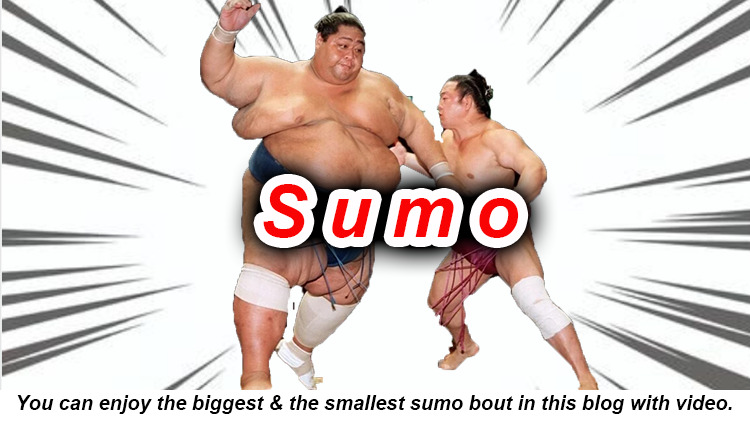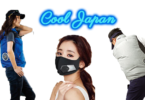Hello how are you? Have you ever heard of ” Sumo” which is classic representative “Cool Japan” before or seen it already?
First of all, enjoy the biggest and the smallest sumo bout at the time of 1994~1997 in the blog with video, please.
Contents
Why was sumo born?
As the origin of our country’s sumo, there are myths of power competitions found in the Kojiki (712 AD) and the Nihon Shoki (720 AD), as well as legends of the Tenran-shobu between Sukune and Kehaya.
Sumo was originally performed as a ritual festival to predict the harvest of crops for the year. It later became a court event and continued for over 2,000 years.
What’s Sumo ?
A 2,000-year-old form of wrestling that is considered by many to be the national sport of Japan. Sumo became a professional sport in the early Edo period (1600-1868), and although it is practiced today by clubs in high schools, colleges, and amateur associations, it has its greatest appeal as a professional spectator sport.
The object of this sport is for a wrestler to force his opponent out the dohyo (A sumo ring made of earth) or cause him to touch the surface of the dohyo with any part of his body other than the soles of his feet.
The sumo wrestlers may spend as much as the first four minutes in the ring in a ritual of stamping, squatting, puffing, glowering, and ★tossing salt in the air, but the actual conflict is only a matter of seconds.
★ Why do they sprinkle・toss salt before sumo battle?
Japanese people have long believed that salt has a purifying effect. Therefore, when sumo wrestlers sprinkle salt, it signifies the cleansing of the dohyo (sumo ring).
In other words, they sprinkle salt to purify the ring before the battle begins.
To decide who has stepped out or touched down first is often extremely difficult and requires the closest attention of gyouji (a referee), dressed in the court costume of a 14th -century nobleman, on the dohyo and judges shitting around the dohyo at floor level.
The Japan Sumo Association, the governing body of professional sumo, officially lists 70 winning techniques consisiting of assorted throws, trips, lifts, thrusts, shoves, and pulls.
Of these, 48 are considered the “classic” techniques but the number in actual daily use is probably half that. Of primary concern in sumo are ring decorum and sportsmanship.
Unique to sumo is the use of a belly band or belt called a mawashi (loincloth). Most sumo matches center on the wrestlers’attempts to get a firm, two-handed grip on their opponent’s mawashi while blocking him from getting a similar grip on theirs.
During tounaments, a string apron is also worn tucked in to the front folds of the mawashi, hence it falls frequently in the heat of the match.
The Wrestlers
Traditionally sumo has drawn the majority of its recruits from rural communities. Most wrestlers start in their mid-teen and retire from this rigorous sport in their early thirties.
Top-ranking wrestlers have a average height of 185 centimeters (6ft) and an average weight of 148 kilograms (326 lb).
The wrestlers in professional sumo are organized into a pyramid. Progress from the ranks of beginners at the bottom to the grand champion’s pinnacle at the top depends entirely on ability.
The speed with which a wrestler rises or falls depends entirely on his win-loss record at the end of each tournament.

His ring name is Konishiki from Hawai, he was 184 cm tall(6ft) and 287 kg(632lb)
Based on this, his ranking is calculated for the next tounament and then written with his name and those of other wrestlers in Chinese characters on a graded list called the banzuke (a ranking/graded list of sumo wrestlers).
The only permanent rank is that of yokozuna, ” grand champion”, but a yokozuna who can not maintain a certain level of championship performance is expected to retire.
Only wrestlers in the top two divisions, juryou and makuuchi, receive regular salaries. They also enjoy the title sekitori, “top-ranking wrestler”, and the right to have their long, oiled hair combed into the elegant oichomage (ginkgo-leaf knot) during tounaments.
At the same time, Georgian wrestler Tochinoshin was officially promoted to sumo’s second-highest rank of “Ozeki” by the Japan Sumo Association on Wednesday.
The 30-year-old, whose real name is Levan Gorgadze, became the third European wrestler to reach the rank, moving up from sekiwake.

Congratulations on promotion to Ozeki for Ichinoshin!
Both of them are well worth enough receiving such glorious prize after making hard-strenuous training effort under strict rules and customs while acquiring Japanese language for many years.
How to see a sumo tournament
The best way to see sumo is to attend a sumo tournament. Tickets are sold for each day of the 15-day tournaments.
They can be purchase in advance through the official vendor or via buysumotickets.com.
Alternatively, they can be purchased at convenience stores (some Japanese skills required) or at the stadiums.
Three types of seats are available to regular visitors:
★ Ringside seats:
Located closest to the ring, ringside seats are most expensive and most difficult to get.
Ticket holders sit on cushions on the floor and are exposed to the risk of injury due to wrestlers flying into the spectators.
★ Box seats:
The rest of the stadium’s first floor consists of Japanese style box seats, which generally seat four people (although there are a few with higher and lower capacities, as well).
Shoes are removed, and spectators sit on cushions. Tickets are sold for entire boxes regardless of whether they are fully occupied or not, i.e. two people using a 4-seat box will still have to purchase all four tickets.
Box seats are further classified into A, B and C boxes according to distance to the ring.
★ Balcony seats:
On the second floor balcony, there are several rows of Western-style seats. Balcony seats, too, are further classified into A, B and C seats depending on distance to the ring.
Furthermore, there is one section for exclusive use by holders of same-day tickets, the cheapest ticket type that can only be purchased on the day at the stadium.
The stadium often sells out, especially on weekends and national holidays. But even if a day is sold out in advance, a limited number of same-day balcony seat tickets are sold on the day at the stadium. Sumo tickets go on sale roughly one month before the start of each tournament.

Box seats at the Osaka Prefectural Gymnasium
A tournament day
Lower division matches start from 8:30 (from 10:00 on days 13-15), second division (Juryo) matches from 15:00 and top division (Makuuchi) matches from 16:00.
Ring entering ceremonies between divisions are also interesting to watch. The highest ranked wrestlers have their matches just before 18:00.
On the last day of each tournament, the schedule is shifted forward by 30 minutes to accommodate the victory ceremony at the end.
The stadium atmosphere improves with the arrival of more spectators as it gets later in the day when the most spectacular matches happen.
Intervals between bouts also lengthen as they include longer preparation times and more pre-match action between the high-ranked wrestlers.
We recommend spectators with limited time to be present at the stadium at least for the top division action between 15:30 and 18:00.

inside the Kokugikan stadium in Tokyo
Annual Tounaments
Traditionally only two tournaments were held each year, but by 1958 this number had grown to six, where it stood in the 1990s. The big six are held every other month in four different cities.
In 1949 the length of a tournament increased from the traditional 10 days to 15 days. A tounament day starts with the apprentices of maezumo (pre-sumo) fighting, then the long march of the four lower divisions.
The boy-men in these divisions-jonokuchi, jonidan, sandamme, and makushita-wrestle on 7 of the 15 days of the tournament. For them a winning record begins with 4 wins against 3 losses, which ensures promotion.
Sekitori in the juryo and makuuchi divisions wrestle once a day for 15 days. Sekitori must win 8 of their 15 bouts for a kachikoshhi record. The entire tounament is won by the makuuchi wrestler with the most wins.
The Stable System
The sumo stable system has as it purpose the training of young wrestlers into senior champions while inculcating them with the strict etiquette, discipline, and special values of sumo.
Physically, a stable is a self-contained unit complete with all living-training facilities. Every professional sumo wrestler belongs to one, making it his home throughout his ring career and often even into retirement.
The only exceptions to the live-in rule are the married sekitori, who may live outside with their wives and commute to daily practice at the stable. As of January 2018 there were 45 active stables.
A stable is managed under the absolute control of a single boss, oyakata. All boss are former senior wrestlers and members of ther Japan Sumo Association.
The stable they run is usually the stable where they wrestled.
Boss are generally marrried and live in special quarters with their wives, known by the title of okamisan, the only women to live in stable.
Stable expenses are paid for by regular allowances from the Japan Sumo Association and gifts from the stable fan club.
Sumo Practice
Keiko,”practice”, is a sacred word in sumo. The day begins at 4:00 or 5:00 AM for the youngest, lowest-ranked wrestlers, who ready the ring and begin their exercises.
The higher a wrestler’s rank, the longer he may sleep. Makusita are up at 6:30 and in the ring at 7:00. Jyuryou wrestlers enter the ring around 8:00 and makunouchi shortly after.
At 11:00 AM the wrestlers head for the baths, seniors first, followed by the lower ranks. Next is chankonabe brunch, the first and largest meal of the day.
The Japan Sumo Association
Every aspect of professional sumo is controlled by the Japan Sumo Association, composed of over 100 retired wrestlers known as elders and including representaion from sumo’s working ranks, i.e. active wrestlers, referees and ring stewards, yobidashi (a caller).
When and where next tournament will be held ?
On July 8th, Sunday 2018 at Nagoya will be held for 15 days. Therefore we are looking forward to the day.
We have other related sumo blogs as follows, 1) U.S. President Trump Presents The “President’s Cup” To Sumo Tournament Winner, 2) The Second Oldest Iron Sumo Wrestler “Tamawashi, 3) Young Sumo’s Maiden Victory Herald New Generation On The Rise, to be well worth browsing












